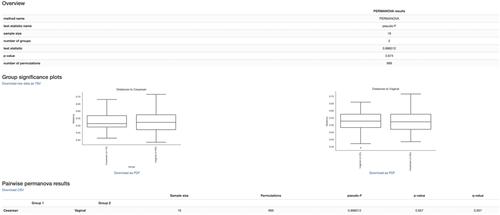QIIME 2 Enables Comprehensive End-to-End Analysis of Diverse Microbiome Data and Comparative Studies with Publicly Available Data
Q1 Biochemistry, Genetics and Molecular Biology
Mehrbod Estaki, Lingjing Jiang, Nicholas A. Bokulich, Daniel McDonald, Antonio González, Tomasz Kosciolek, Cameron Martino, Qiyun Zhu, Amanda Birmingham, Yoshiki Vázquez-Baeza, Matthew R. Dillon, Evan Bolyen, J. Gregory Caporaso, Rob Knight
下载PDF
{"title":"QIIME 2 Enables Comprehensive End-to-End Analysis of Diverse Microbiome Data and Comparative Studies with Publicly Available Data","authors":"Mehrbod Estaki, Lingjing Jiang, Nicholas A. Bokulich, Daniel McDonald, Antonio González, Tomasz Kosciolek, Cameron Martino, Qiyun Zhu, Amanda Birmingham, Yoshiki Vázquez-Baeza, Matthew R. Dillon, Evan Bolyen, J. Gregory Caporaso, Rob Knight","doi":"10.1002/cpbi.100","DOIUrl":null,"url":null,"abstract":"<p>QIIME 2 is a completely re-engineered microbiome bioinformatics platform based on the popular QIIME platform, which it has replaced. QIIME 2 facilitates comprehensive and fully reproducible microbiome data science, improving accessibility to diverse users by adding multiple user interfaces. QIIME 2 can be combined with Qiita, an open-source web-based platform, to re-use available data for meta-analysis. The following basic protocol describes how to install QIIME 2 on a single computer and analyze microbiome sequence data, from processing of raw DNA sequence reads through generating publishable interactive figures. These interactive figures allow readers of a study to interact with data with the same ease as its authors, advancing microbiome science transparency and reproducibility. We also show how plug-ins developed by the community to add analysis capabilities can be installed and used with QIIME 2, enhancing various aspects of microbiome analyses—e.g., improving taxonomic classification accuracy. Finally, we illustrate how users can perform meta-analyses combining different datasets using readily available public data through Qiita. In this tutorial, we analyze a subset of the Early Childhood Antibiotics and the Microbiome (ECAM) study, which tracked the microbiome composition and development of 43 infants in the United States from birth to 2 years of age, identifying microbiome associations with antibiotic exposure, delivery mode, and diet. For more information about QIIME 2, see https://qiime2.org. To troubleshoot or ask questions about QIIME 2 and microbiome analysis, join the active community at https://forum.qiime2.org. © 2020 The Authors.</p><p><b>Basic Protocol</b>: Using QIIME 2 with microbiome data</p><p><b>Support Protocol</b>: Further microbiome analyses</p>","PeriodicalId":10958,"journal":{"name":"Current protocols in bioinformatics","volume":"70 1","pages":""},"PeriodicalIF":0.0000,"publicationDate":"2020-04-28","publicationTypes":"Journal Article","fieldsOfStudy":null,"isOpenAccess":false,"openAccessPdf":"https://sci-hub-pdf.com/10.1002/cpbi.100","citationCount":"165","resultStr":null,"platform":"Semanticscholar","paperid":null,"PeriodicalName":"Current protocols in bioinformatics","FirstCategoryId":"1085","ListUrlMain":"https://onlinelibrary.wiley.com/doi/10.1002/cpbi.100","RegionNum":0,"RegionCategory":null,"ArticlePicture":[],"TitleCN":null,"AbstractTextCN":null,"PMCID":null,"EPubDate":"","PubModel":"","JCR":"Q1","JCRName":"Biochemistry, Genetics and Molecular Biology","Score":null,"Total":0}
引用次数: 165
引用
批量引用
Abstract
QIIME 2 is a completely re-engineered microbiome bioinformatics platform based on the popular QIIME platform, which it has replaced. QIIME 2 facilitates comprehensive and fully reproducible microbiome data science, improving accessibility to diverse users by adding multiple user interfaces. QIIME 2 can be combined with Qiita, an open-source web-based platform, to re-use available data for meta-analysis. The following basic protocol describes how to install QIIME 2 on a single computer and analyze microbiome sequence data, from processing of raw DNA sequence reads through generating publishable interactive figures. These interactive figures allow readers of a study to interact with data with the same ease as its authors, advancing microbiome science transparency and reproducibility. We also show how plug-ins developed by the community to add analysis capabilities can be installed and used with QIIME 2, enhancing various aspects of microbiome analyses—e.g., improving taxonomic classification accuracy. Finally, we illustrate how users can perform meta-analyses combining different datasets using readily available public data through Qiita. In this tutorial, we analyze a subset of the Early Childhood Antibiotics and the Microbiome (ECAM) study, which tracked the microbiome composition and development of 43 infants in the United States from birth to 2 years of age, identifying microbiome associations with antibiotic exposure, delivery mode, and diet. For more information about QIIME 2, see https://qiime2.org. To troubleshoot or ask questions about QIIME 2 and microbiome analysis, join the active community at https://forum.qiime2.org. © 2020 The Authors.
Basic Protocol : Using QIIME 2 with microbiome data
Support Protocol : Further microbiome analyses
QIIME 2能够对不同微生物组数据进行全面的端到端分析,并与公开数据进行比较研究。
QIIME 2是一个完全重新设计的微生物组生物信息学平台,基于流行的QIIME平台,它已经取代了QIIME。QIIME 2促进了全面和完全可复制的微生物组数据科学,通过添加多个用户界面提高了对不同用户的可访问性。QIIME 2可以与Qiita(一个基于web的开源平台)结合,重新使用可用数据进行元分析。下面的基本协议描述了如何在单个计算机上安装QIIME 2并分析微生物组序列数据,从处理原始DNA序列读取到生成可发布的交互式数据。这些交互式数据使研究的读者可以像作者一样轻松地与数据交互,从而提高微生物组科学的透明度和可重复性。我们还展示了社区开发的插件如何添加分析功能,并与QIIME 2一起安装和使用,从而增强微生物组分析的各个方面。,提高分类学分类精度。最后,我们说明了用户如何通过Qiita使用现成的公共数据组合不同的数据集进行元分析。在本教程中,我们分析了早期儿童抗生素和微生物组(ECAM)研究的一个子集,该研究跟踪了43名美国婴儿从出生到2岁的微生物组组成和发育,确定了微生物组与抗生素暴露、分娩方式和饮食的关系。有关QIIME 2的更多信息,请参见https://qiime2.org。要解决问题或询问有关QIIME 2和微生物组分析的问题,请加入活跃的社区https://forum.qiime2.org。©2020作者。基本协议:使用QIIME 2与微生物组数据支持协议:进一步的微生物组分析
本文章由计算机程序翻译,如有差异,请以英文原文为准。


 求助内容:
求助内容: 应助结果提醒方式:
应助结果提醒方式:


